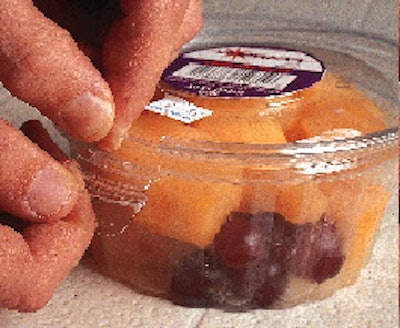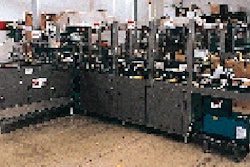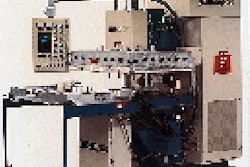Food retailers are experiencing strong growth in delis, in-store bakeries and salad bars. At the same time, more and more food retailers are remaining open around the clock. Faced with these changes in their traditional methods of operation, it's little wonder that retailers are seeking new in-store packaging options to cope with these new challenges. Retailers aren't only concerned about product preservation and safety, either. They want the packaging to help merchandise their foods. Responding to these needs, Wilkinson Mfg. Co. (Fort Calhoun, NE) is producing what it calls the industry's first resealable, tamper-evident bulk-food packaging for food retailers. Thermoformed from oriented polystyrene, Wilkinson's two-piece DeltaPak(TM) container is available in a variety of sizes ranging from 8- to 128-oz tubs. "Growing consumer demand for high-quality food prepared on premise by retailers has created a huge surge in demand for in-store packaging," says Ray Salinas, vice president of marketing at Wilkinson. "For consumers with discriminating taste, traditional stretch wrap and trays are just not adequate anymore. The challenge is how to preserve freshness, nutritional value, flavor and aroma while presenting the product attractively and safely." The DeltaPak addresses these challenges head on, says Salinas. Its domed lid fits snugly, providing a secure seal that helps preserve freshness, texture, flavor and aroma, he points out. And the breakaway "tamper tab" provides instant tamper evidence. Moreover, Wilkinson's use of 1800L high-heat crystal PS resin from BASF (Mount Olive, NJ) provides assurance that the product will not be tainted by off flavors or odors. "The BASF resin offers the lowest residuals on the market," says Salinas. At the same time, the resin's clarity and gloss help improve food merchandising. "Stretch wrap distorts what's inside a package," Salinas says. "Food is more appetizing when it's displayed in an attractive, clear, glossy package." Fruit processor likes it, too Managers of in-store bakeries and delis aren't the only ones who appreciate the DeltaPak. There are also firms like Pearson Foods Corp. of Grand Rapids, MI. This processor of fresh-cut produce, whose major markets are in Detroit and Chicago, began using the DeltaPak in April for its line of prepared fresh fruits. "The product displays beautifully," says Pearson vice president of marketing Sandra Arnold. Company president David Pearson says improved clarity compared to the clamshell of polyethylene terephthalate used formerly was indeed one of two main reasons for making the switch. The other motivator was the TE feature. "Historically if you want a tamper-evident seal on this style of package you have to drop a plastic ring around it and heat shrink it in place," says Pearson. "This is the only package we've found that has its own tamper-evident tab." Pearson likes not having to add the heat-shrinkable seal. He also likes the cost savings that come with not having a separate packaging step. Also a big improvement, says Pearson, is the elimination of the shrink tunnel formerly used to shrink the TE band. "I never really liked having a source of heat like that in a refrigerated packing room," says Pearson. The new package even costs him less than the polyethylene terephthalate clamshell and TE shrink band it replaced. But the difference, says Pearson, is nominal. Extruder designed in-house Wilkinson extrudes its own sheet and thermoforms it into containers and domed lids in its Fort Calhoun facility. The firm uses a 6" extruder barrel-and-die combination designed largely in-house. Upon leaving the extrusion die, a three-roll vertical stack chills the freshly extruded sheet, then four more chill rolls in a stack configuration chill it further to the temperature at which orienting begins, about 250°F. Machine-direction orientation is done by a series of four stretch rollers. Then comes transverse orientation, which is performed by chain grippers that grab each side of the material and gradually stretch the sheet. In this process, the sheet goes from some 36" wide up to 80" wide. It also thins out from 125-mil to about 22-mil on sheet to be formed into DeltaPak tubs. Sheet destined for lid forming goes from 100-mil to 18-mil. Edges are trimmed about 3" wide from each side of the sheet. The trim is ground and sent immediately back up to the extruder to come out in the sheet a few minutes later. The final step before slitting is silicone coating on both sides. "The coating helps in mold release after thermoforming," says Wilkin-son vice president Herb Borst, who oversees extrusion. "Some of the containers require pretty deep draws, and the coating helps the plastic dislodge itself from the mold. Also, the silicone coating means that the lid slips on more smoothly than if you're handling two pieces of uncoated material." After coating, the sheet is slit into whatever widths are called for and rewound. The rolls then await thermoforming, though as Borst puts it, "Lately they've been taking it straight to the thermoformer about as fast as we can extrude and slit it. The package is really taking off." Consistency counts "Lack of consistency in a resin can make polystyrene sheet extrusion and orientation a nightmare," says Borst. "There are so many variables involved and no manuals to serve as a guide. Consistent resin quality gives us the assurance that just the right amount is coming out of the extruder. With the BASF resin, the melt flow is consistent and there are very few fines." The "fines" Borst refers to are extremely fine particles of the resin that break away from the pellets in the ordinary course of handling. Unlike pellets, fines are difficult to melt properly. "In the case of a pellet," explains Borst, "much of the melting is a result of shear as much as it is the heat itself. But the fines are so small they just sort of roll around with the flow without getting properly melted like the pellets." Borst says he's not sure precisely how BASF manages to deliver such "fine-free" resin. All he knows is that "When the rail car gets here, there are very few fines left at the bottom of it. It's important, too, because fines make the sheet look like it's been sandblasted because all those little particles aren't melted." The consistency and quality of the resin has enabled Wilkinson to reduce scrap and increase regrind quality. "If you start off with good clear sheet, you end up with good clear sheet," says Ray Massey, Jr., vice president of operations at Wilkinson. "If you regrind sheet that was murky, your finished product will be murky." Selecting a resin was relatively uncomplicated, but formulating it so that a finished container with the DeltaPak's unusual qualities could be produced was a bit more challenging. The container had to exhibit a seemingly contradictory combination of qualities. The tamper-evident feature had to be rigid enough so that when the consumer cracked the tab, it would break cleanly without tearing the entire package. At the same time, the container had to be resilient enough to permit reclosing. BASF provided support in part design and testing, says Massey. "They made their lab available to us, freeing us from the cost of maintaining our own testing lab," says Massey. Ultimately, the solution was to use BASF's Styrolux® 485 copolymer modifier along with the 1800L resin to increase the container's tear strength. "The modifier gives the container a more rubbery feel and tear-resistant quality," says Borst. Thermoforming At Wilkinson, thermoforming of the tubs is done on a Model C 4500 system from Brown Machine (Beaverton, MI). The small 8-oz container has a 2" depth of draw and is produced 36-up. At the other extreme, the 128-oz container has a 53/4" depth of draw and is produced 9-up. The 8-, 12-, and 16-oz sizes are produced in one convertible mold. Its cavities take inserts and its plug- assist tools are interchangeable depending on the depth of draw of the container in production. Diameter of each is 4"; only depth of draw changes. A second convertible mold is used for 24-, 32-, 48-, and 84-oz sizes. Again, depth of draw changes for each, but diameter remains constant at 6". A third mold is dedicated to the 128-oz size with its 53/4" draw and 10" diameter. Lids are formed on a Brown C 4200 system that sits right beside the C 4500 machine. Lids come in 4", 6", and 10" diameters, but depth of draw is consistently the same at about 1". After thermoforming, individual parts are cut from the web by a Brown trim press. Finally, they're ejected onto a table in long rows of nested tubs. The rows are manually packed into corrugated shippers. As sales of DeltaPaks continue to grow, Salinas says he's a little surprised that the feature retailers say they like best is the tightness of the snap-fit seal and the product freshness it brings. "They recognize the tamper-evident feature, but it's not a key concern," says Salinas. "What is a key concern is the ineffectiveness of the seal they were getting in other hinged or OPS products. The seal is driving a lot of our sales."























